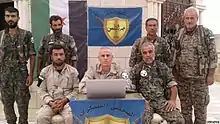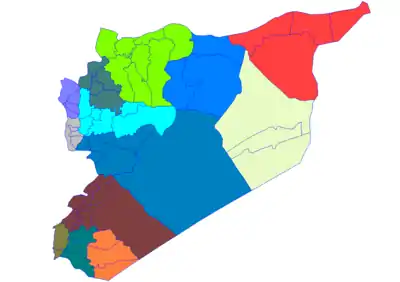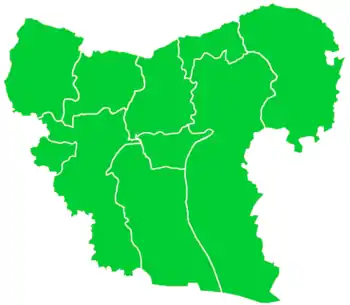Jarabulus
Jarabulus (Arabic: جَرَابُلُس, ALA-LC: Jarābulus, Aleppo dialect: Jrāblos; Turkish: Cerablus or Carablus; Kurdish: Cerablûs[2]) is a Syrian city administratively belonging to Aleppo Governorate, under the de facto control of the Syrian Opposition. Jarabulus lies on the western bank of the Euphrates and north of Lake Assad, just south of the Syria–Turkey border and the Turkish town of Karkamış. In the 2004 census, the city had a population of 11,570.[1] The population has increased significantly during the Syrian civil war.
Jarabulus
جَرَابُلُس Cerablus | |
|---|---|
Town | |
 Jarabulus Location of Jarabulus in Syria | |
| Coordinates: 36°49′03″N 38°00′40″E | |
| Country | |
| Governorate | Aleppo |
| District | Jarabulus |
| Subdistrict | Jarabulus |
| Control | |
| Elevation | 367 m (1,204 ft) |
| Population (2004)[1] | 11,570 |
| Time zone | UTC+2 (EET) |
| • Summer (DST) | UTC+3 (EEST) |
| Geocode | C2227 |

History
In the Bronze and Iron Ages, the archaeological site lying just north of Jarabulus (half of which is now in Turkey) was called Karkemish, in Greek and Roman times the ancient name of the city was "Europos" (Εὐρωπός), which must have been at the origin of the modern form of the toponym Jerabis.
The original 18th century form of the toponym seems to have been "Djerabis", later found however as "Djeraboolos" or "Djerablus", probably deriving from Hierapolis (modern-day Manbij, to the southwest).
Being on the southern side of the Istanbul-Baghdad railway, Jarabulus became a border town with Turkey based on the Treaty of Lausanne in the aftermath of World War I.
Following the outbreak of the Syrian civil war, the Syrian opposition took over the town, along with its border post with Turkey on July 20, 2012. However in July 2013 the town was captured by the Islamic State of Iraq and the Levant.[3][4] By January 2014, rebels mainly from the al-Tawhid Brigade engaged in clashes with ISIL and seized the town, but ISIL was able to recapture it within hours.[5]
An article published by The Guardian said that attempts by the People's Protection Units (YPG) to capture Jarabulus were prevented by President Recep Tayyip Erdoğan, who, according to media reports, had threatened in 2015 to attack the YPG if they moved against Jarabulus. This threat secured ISIL control of the town.[6]
Operation Euphrates Shield
On 24 August 2016 around 4:00 AM (local time), Turkey-backed rebels and the Turkish Army launched a military operation into Syria. The operation was supported by the Turkish Air Force along with US-led coalition aircraft in an attempt to clear a passage for the troops. By 24 August, Jarabulus and neighboring towns were captured by the Syrian National Army.[7] The SNA, backed by Turkish tanks, then connected Jarablus to al-Rai to push ISIL forces away from the Turkish border.
Demographics
Ethnically, the city is mostly composed of Arabs[8] and Turkmens.[9][10] Turkmens belong to the Barak tribe.[11] The region overall likewise mostly consists of Arabs and Turkmens,[12][13] but also houses the heterogenous Kurdish tribal confederation of Barazi, which also includes Arabs, from Jarabulus eastwards to Suruç. There are 16 thousand Kurds living near Jarabulus.[14]
When British archaeologist David George Hogarth visited Jarabulus in early 20th century, he noted that the town was held by Arabs of the Geais Msahaleh clan and Turks of the Barak clan.[15]
Governance

On 6 September 2016, the Karkamış-based council of Jarabulus that had been constituted 2 years prior, accused Turkey of attempting to replace them with a newly formed council consisting of pro-Turkish Turkmen separatists. The Sultan Murad Division denied the accusations and accused the local council of being PYD "collaborators", although it did confirm forming a "council of elders" in the city. Harakat Nour al-Din al-Zenki's political leader Yasser Ibrahim al-Yusuf, son of the perpetrator of the Aleppo Artillery School massacre, also said that the city would be governed by a newly formed council.[16] The head of the Syrian Interim Government based in Turkey, Jawad Abu Hatab, has met with the Jarabulus local council on the same day.[17]
Security
On 22 January 2017, a police force of 450 members trained and equipped by Turkey was deployed in Jarabulus.[18] The Jarabulus police is headed by defected Syrian Army brigadier general Abdel Razaq Aslan.[19]
Education
Following the capture of Jarabulus by the Turkish Armed Forces from the Islamic State, children returned to school, learning Turkish as a foreign language instead of French.[20] In October 2018, the Gaziantep University opened a vocational school in Jarabulus.[21]
Infrastructure
After the Turkish operation in August and September 2016, Turkish authorities planned to restore electricity to the city by building a three kilometres (1.9 miles) cable from Karkamış to Jarabulus, with two kilometres (1.2 miles) being in Syrian territory. Electricity and potable water was announced to be provided for free.[22]
Later that month, after visits from Turkish officials and the mayor of Gaziantep Municipality, Jarabulus was connected to the Turkish electrical grid. A former school in Jarabulus was turned into a hospital with an official Turkish sign reading "Turkish Ministry of Health - Jarablus Hospital" with a flag of Turkey.[23]
Climate
Jarabulus has a hot-summer Mediterranean climate (Köppen climate classification Csa), with influences of a continental climate during winter, hot dry summers, and cool wet and occasionally snowy winters. The average high temperature in January is 7.8 °C (46.0 °F) and the average high temperature in August is 38.1 °C (100.6 °F). The snow falls usually in January, February or December.
| Climate data for Jarabulus | |||||||||||||
|---|---|---|---|---|---|---|---|---|---|---|---|---|---|
| Month | Jan | Feb | Mar | Apr | May | Jun | Jul | Aug | Sep | Oct | Nov | Dec | Year |
| Average high °C (°F) | 8.0 (46.4) |
10.5 (50.9) |
16.1 (61.0) |
23.4 (74.1) |
28.7 (83.7) |
34.3 (93.7) |
37.7 (99.9) |
38.5 (101.3) |
34.2 (93.6) |
26.8 (80.2) |
16.3 (61.3) |
9.9 (49.8) |
23.7 (74.7) |
| Average low °C (°F) | −1.2 (29.8) |
−0.6 (30.9) |
4.3 (39.7) |
7.2 (45.0) |
12.5 (54.5) |
15.1 (59.2) |
19.9 (67.8) |
20.9 (69.6) |
16.3 (61.3) |
12.4 (54.3) |
6.4 (43.5) |
−0.5 (31.1) |
9.4 (48.9) |
| Average precipitation mm (inches) | 71 (2.8) |
49 (1.9) |
39 (1.5) |
35 (1.4) |
20 (0.8) |
3 (0.1) |
0 (0) |
0 (0) |
3 (0.1) |
21 (0.8) |
32 (1.3) |
64 (2.5) |
337 (13.2) |
| Average rainy days | 12 | 8 | 6 | 4 | 4 | 1 | 0 | 0 | 1 | 3 | 5 | 10 | 54 |
| Average snowy days | 2.0 | 1.0 | 0 | 0 | 0 | 0 | 0 | 0 | 0 | 0 | 0 | 1.5 | 4.5 |
| Average relative humidity (%) | 75 | 67 | 60 | 56 | 42 | 40 | 35 | 35 | 44 | 47 | 55 | 74 | 53 |
| Source: Weather Online, Weather Base, BBC Weather and My Weather 2 | |||||||||||||
References
- "2004 Census Data for Nahiya Jarabulus" (in Arabic). Syrian Central Bureau of Statistics. Also available in English: UN OCHA. "2004 Census Data". Humanitarian Data Exchange.
- "Li Cerablûs û Babê teqînên hevdem". Rudaw. 2023-04-13. Retrieved 2023-04-13.
- "The Islamic State of Iraq and ash-Sham Expands Into Rural Northern Syria". Syria Comment. 2013-07-18. Retrieved 2023-04-13.
- Walsh, Nick Paton (2013-11-04). "The secret jihadi smuggling route through Turkey". CNN. Retrieved 2023-04-13.
- "Syrian rebels push Qaeda affiliate from northwest stronghold". Chicago Tribune (Reuters). 17 January 2014. Archived from the original on 18 January 2014.
- Graeber, David (18 November 2015). "Turkey could cut off Islamic State's supply lines. So why doesn't it?". The Guardian.
- Post, Washington (24 August 2016). "Syrian rebels backed by Turkish tanks capture key border stronghold from ISIL". National Post.
- Demir, Turgay (2023). Syrian Kurds, the Democratic Union Party (PYD), and the Strategic Framing of the Civil War: Selling the New Model of Governance. Lexington Books. p. 130.
Arab-majority areas such as Manbij and Jarabulus (Kusilek, 2019)
- "ARGUMENTS ON SAFE HAVENS IN SYRIA: RISKS, OPPORTUNITIES AND SCENARIOS FOR TURKEY" (PDF). ORSAM. CENTER FOR MIDDLE EASTERN STRATEGIC STUDIES. Archived from the original (PDF) on 2013-12-27.
- Khalifa, Mustafa. "The impossible partition of Syria" (PDF). Thematic Studies. Arab Reform Initiative. Archived from the original (PDF) on December 27, 2013. Retrieved 27 December 2013.
- Tanyol, Cahit (1952). "Baraklarda Örf ve Adet Araştırmaları 1". İstanbul University Journal of Sociology. 2 (7): 71–108. Retrieved 13 April 2023.
- van Wilgenburg, Wladimir. "Kurdish Strategy Towards Ethnically-Mixed Areas in the Syrian Conflict". Terrorism Monitor Volume: 11 Issue: 23. The Jamestown Foundation. Retrieved 27 December 2013.
- Khalifa, Mustafa. "The impossible partition of Syria" (PDF). Thematic Studies. Arab Reform Initiative. Archived from the original (PDF) on December 27, 2013. Retrieved 27 December 2013.
- Tejel, Jordi (2009). Syria's Kurds: History, Politics and Society. Translated by Welle, Emily (1. publ. ed.). London: Routledge. pp. 10. ISBN 978-0-203-89211-4.
- Hogarth, David George (1914). Carchemish: Report on the Excavations at Djerabis on Behalf of the British Museum. Order of the Trustees. p. 24.
- "Jarablus and the local council". Yalla Souriya. 6 September 2016.
- "Free Syria Army withdraws from Jarablus bases, cites disagreements with separatists". Al-Masdar News. 6 September 2016. Archived from the original on 28 September 2020. Retrieved 8 September 2016.
- Postings, Robert (2018-02-07). "Free Syria Police: Creating Security and Stability". International Review. Retrieved 2019-11-03.
- Ashawi, Khalil (2017-01-24). "Hundreds of police trained by Turkey start work in northern Syria". Reuters. Retrieved 2020-05-03.
- "Turkey helps rebuild the liberated Syrian border town of Jarabulus". France 24. 2017-12-15. Retrieved 2019-11-03.
- "Erdogan approves 3 Turkish university campuses for northern Syria". www.rudaw.net. Retrieved 2019-11-03.
- "Turkey sends power lines into Syrian town cleared of IS". Middle East Eye. 8 September 2016.
- "Cerablus'ta atıl okul binası hastaneye dönüştürüldü". Anadolu Agency. 26 September 2016. Retrieved 27 September 2016.


